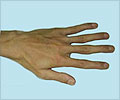As the standard therapy, an investigational treatment for Marfan syndrome is also effective in slowing the enlargement of aorta, the large artery of the heart that carries blood to the body.

The results are presented on Nov. 18, at the American Heart Association''s annual meeting in Chicago and will appear online the same day in The New England Journal of Medicine.
"For years, standard medical therapy for Marfan syndrome consisted of giving patients beta blockers, which lower heart rate and blood pressure, reducing stress on the wall of the aorta," said study co-author Alan C. Braverman, MD, a cardiologist at Washington University School of Medicine in St. Louis. "This new study suggests that we have a second option for patients that appears to be as effective as standard treatment."
The second option is Losartan, an angiotensin receptor blocker. Past research in mice and smaller clinical trials suggested that this class of drugs might actually be superior to beta blocker treatment for Marfan syndrome. Angiotensin receptor blockers commonly are prescribed to treat high blood pressure.
People with Marfan syndrome have weak connective tissues and tend to develop unusually long arms, legs and fingers. In addition to heart problems, patients often develop problems with the eyes, lungs, bones and joints. Patients with the condition are at high risk of sudden death from a tear in the aorta, also called an aortic dissection.
Though there is no cure for Marfan syndrome, treatment with beta blockers and preventive surgery to replace the section of the aorta adjacent to the heart has increased lifespan to near normal. But physicians have continued to look for more effective therapies, especially since some patients on beta blockers experience side effects such as tiredness and nausea.
Advertisement
The study included 608 patients with Marfan syndrome at 21 medical centers nationwide. Patients were ages 6 months to 25 years and had enlarged aortas. Half of these participants were randomly given Losartan, the investigational treatment, and the other half received Atenolol, the standard therapy, but in higher doses than physicians typically prescribe to see if this would increase the beta blocker''s effectiveness.
Advertisement
"This trial demonstrated that Marfan patients treated with either Atenolol or Losartan had very slow rates of aortic growth, and each group tolerated their medications well," said Braverman, who treats patients at Barnes-Jewish Hospital. "While beta blockers may be the gold standard for this condition, these results suggest we must use effective doses. This is also an important alternative therapy for the smaller number of patients who are intolerant to beta blockers."
Braverman also pointed out that ongoing research, including clinical trials currently underway, will continue to shed light on the different effects of these drugs. Investigators would like to determine whether factors such as a patient''s genetic makeup, age and severity of disease favor one drug over the other, or a combination of the two.
Source-Newswise













